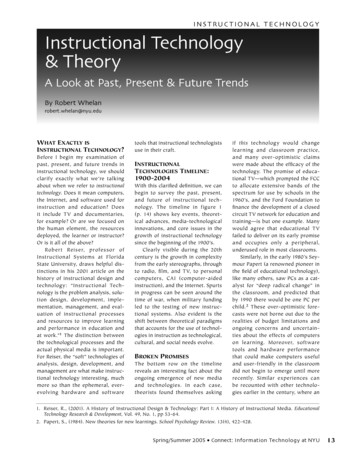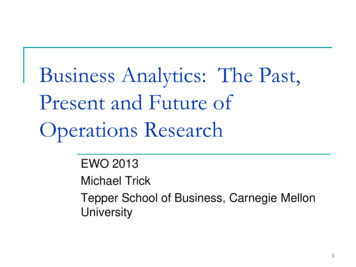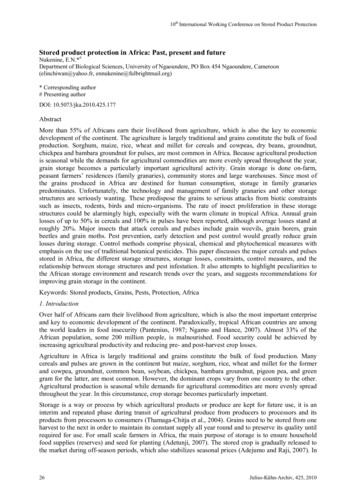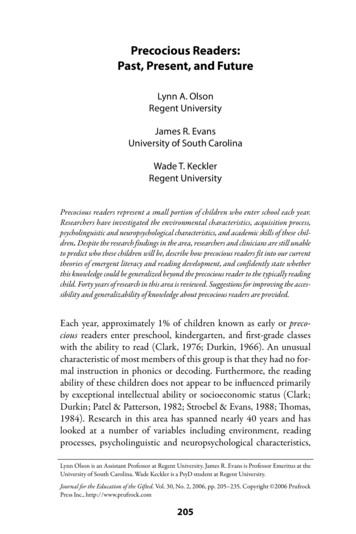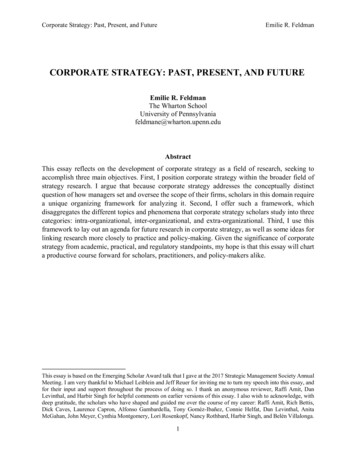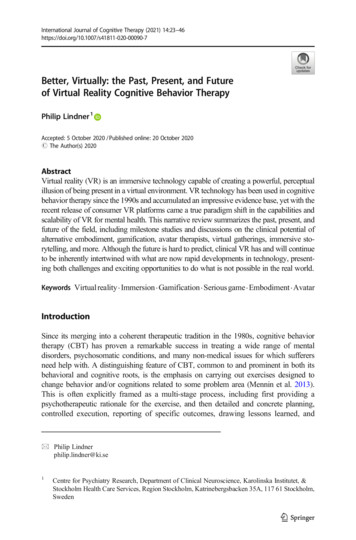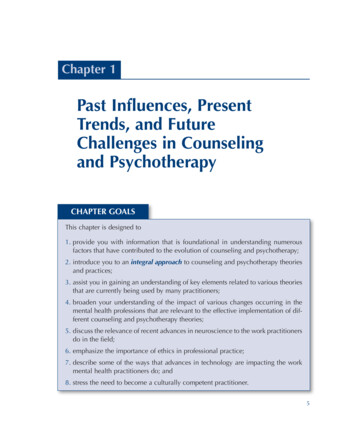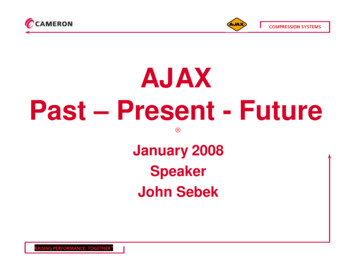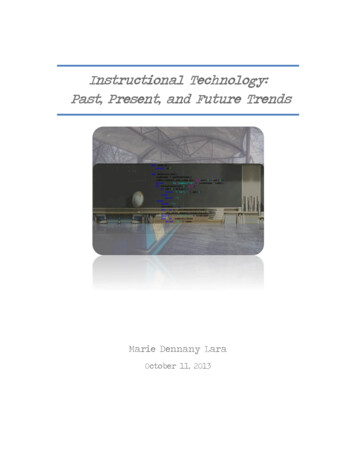
Transcription
Instructional Technology:Past, Present, and Future TrendsMarie Dennany LaraOctober 11, 2013
Instructional Technology: Past, Present, and Future Trends“The number one benefit of information technology is that it empowers people to do what theywant to do. It lets people be creative. It lets people be productive. It lets people learn things theydidn't think they could learn before, and so in a sense it is all about potential.”(Ballmer, 2013)IntroductionThe Organization for Economic Cooperation and Development just put out a reportdocumenting the results of the Survey of Adult Skills – which collated data on adults’ proficiencyin literacy, numeracy and technology-driven problem solving around the globe. (Ferdman, 2013)The group did not need to state that the rankings and information contained were highlyanticipated by business and government leaders alike in this highly competitive global economy.Governments hope to promote their labor markets and show how they are invested in the skills,lives and education of their citizens. While the fact that “Americans rank well below theworldwide average in just about every measure of skill. In math, reading, and technology-drivenproblem-solving, the United States performed worse than nearly every other country in the groupof developed nations. (Ferdman, 2013) It was surprising to learn that an apparent deficiency wasnot the lack of computer literacy per se but an apparent deficiency in Americans “ability tounderstand, evaluate, use and engage with written texts to participate in society, to achieve one’sgoals, and to develop one’s knowledge and potential” (p. 63). This factor points to the fact thatwhile we know that these tools must be made available to our students many elements come to
play in their education. The tools we chose must be able to facilitate the learning process andimprove performance. We must be able to evaluate the results of the assessments and the benefitand utility must be apparent or the course must be changed.Naming and Defining Our FieldInstructional technology and/or Educational technology have numerous definitionsdepending on the context and source in which the terms are utilized. For the most part thedefinition provided by EdTech (Review, 2013), which states that educational technology is the“study and ethical practice for facilitating learning and improving performance by creating, usingand managing appropriate technological processes and resources (para.1)” seems the mostappropriate for the purposes of this report. To begin the process of understanding the field wefirst analyze the nature of discipline and where it originated.Past Instructional TechnologiesSome believe that instructional technology can be traced back to the beginning of humaneducation. The privileged paid the Sophists to teach their young men to speak well, orate andutilize the techne of rhetoric. Plato criticized the fact that the Sophists charged for this trainingand he believed these men to be immoral, catering to the interests of Greek city-states. (Adams,Ph.D., 2000) Actually these “professional teachers” practiced the Ionian scientific tradition,which challenged conventions of the time and touted new and different beliefs. They are said tohave been the first to promote the theory of cognitive knowledge and the concept of humanexcellence. Much of what we know about what they preached comes from criticisms byAristotle, the renowned teacher of Alexander the Great. As further developments in educationaltheories developed the pedagogy for thousands of years remained similar to that of the Greeks.The teacher lectured the students and encouraged rote memorization of mathematical facts,
theories and formulas. Some were encouraged to utilize their innate talents to experiment but forthe most part this was limited to privileged males. As time went on girls and women were taughtin a few fields such as secretarial, as seamstresses and elementary teachers. Eventually astechnology began to represent smarter and efficient methods for getting things done businessesgot into the business of education and built schools to train and educate the populace to operatetheir machines and do the jobs they wanted and needed to get done. These technologiesrepresented progress and the money generated from sales helped the country build weapons,ships, planes, roads and skyscrapers. The United States of America won wars and sold our latesttechnologies abroad.As we developed into a privileged modern society we looked to educate our children, andto the latest technologies that might help accomplish our instructional objectives. Prior to the21st Century we did not ask educators to design the training and curriculums for our schools andother institutions but businessmen and government officials did. Late 19th century and early 20thcentury classrooms contained books, chalk boards, and desks, later attempting to implement theuse of radios, filmstrip projectors, and slides into the mix. The cynical or observant might notethat the businessmen that touted their instructional technology solutions have frequentlypredicted the elimination of textbooks and even teachers.In the 2006 book, Future Hype: The Myths of Technology Change by BobSeidensticker states that in 1922 Thomas Edison predicted that movies would replacetextbooks. In 1945 one forecaster imagined radios as common as blackboards inclassrooms. In the 1960s, B.F. Skinner predicted that teaching machines and programmedinstruction would double the amount of information students could learn in a given time.Filmstrips and other audiovisual aids were fads thirty years ago, and the television, now
seen as a supplier of brain candy, once had a sterling reputation as an education machine.(p.103)This period saw the prevalence of new learning theories such as that of Russianphysiologist Ivan Pavlov, who described classical conditioning theory which could help parentsand educators, understand the origins of disruptive classroom behavior. These learning theorieswere the catalyst for many to develop educational technology solutions utilizing the basicpremises garnering attention at the time. For example, behaviorist guru, B. F. Skinneremphasized stimulus response patterns of conditioned behaviors could be taught utilizing “drilland practice” instructional technology design solutions. The teacher would provide positivefeedback to reinforce desired outcomes. (Whelan, 2013) Jean Piaget’s Stage Theory of CognitiveDevelopment was seminal in the field and highly utilized in various form or fashion in numerousinstructional technologies. His collaborator Seymour Papert expounded on this theory to develophis own constructionism learning theory which incorporated the instructional principle ofproblem-based learning into the classroom. Papert proposed that we do this with a form ofexperiential learning in which the instructors brought IT (instructional technology) into theclassroom and teach the children programming at a very young age. He eventually developed acomputer language for this called LOGO whereas the students could immediately see the resultsof their programming in a written, visual format. An interesting fact is that Seymour Papert issaid to have prophesied in Popular Computing in 1984, that:There won’t be schools in the future . I think the computer will blow up the school.That is, the school defined as something where there are classes, teachers running exams,people structured in groups by age, following a curriculum—all of that (p. 11) (Cuban,2010)
Coinciding with the development of these new learning theories were the tools used toimplement them. The audio visual room began to have much more than an old reel-to-reel filmprojector, it gained a television. The television manufacturers wanted to put a television intoevery classroom and they pushed for higher quality effective productions. One of the biggestsuccess stories of the time is the development of Sesame Street, which combined behaviormodeling with cognitive and affective goals. The Children’s Television Workshop did this withrepetition and humor at a steady pace. It was quickly noted that this worked best for the youngerstudent. Many began to note that older students and adults’ interest waned in educational filmsand television. To this day one of the primary goals is to keep the interest or focus of the studentin the development of learning theories and instructional technologies. The tool cannot beeffective if it is not utilized in some form or fashion. Some concentrated on the softwaredevelopment of programs to incorporate devices that educators saw lacking in the oldercomputer labs that were mostly used for “drill and practice” sessions in the past. States anddistricts did not want to invest millions in computers that were not contributing more to theeducation of the student. Educators and administrators coming of age in the new digital erabegan to contribute insights into the direction of technology implementation in the classroom andin business training rooms across the nation. As discussed in Bloom’s Digital Taxonomy, therehas been an update to the original form of the learning process and much of the methods ofinstruction can often be facilitated by digital media. (Churches, 2009) Any educator looking toincorporate the skills needed today into a curriculum would know that the student can bestaccomplish these tasks with the tools made available in smartphones, tablets, laptops and on theinternet. The speed and ease with which a student can find a relevant book or article online hasincreased exponentially since the days of manual card catalogs and travelling to your local
library. The abundance of relevant sources has caused different, newer concerns that theeducational field has been fearful of since the incorporation of the internet in the classroom.Many teachers were hesitant to allow online encyclopedias and other information they did notunderstand for fear of plagiarism, cut/paste paperwork, irrelevant and just plain wronginformation. Classrooms were quickly aided by plagiarism detection programs and instructorswere trained more and more in the utilization of computer aided instruction and curriculum tools.The technology continues to adapt to the concerns of the consumer.The following graphic illustrates the Instructional Technology Timeline from 1840 to a projecteddate in the near future. (Thomas, 2012)Present Instructional TechnologiesWith the increased reliance on computers in every corner of our life from banking,design, medicine, writing, printing, music and film the view has developed that these new skillsare not only skills that need to be learned, but essentials that need to be taught. The student oftoday is a digital native and his teacher may be as well. The classroom is now buzzing with toolsto help us to do more, learn more and collaborate with almost anyone, anywhere. The latest thingmay be the flipped classroom, where the teacher has filmed her didactic introductory lecture and
the student reviews this for homework, on a tablet, their phone, iPad or in the library ahead oftime. The student then develops questions or if he has none returns to the classroom toimplement what skill or idea was being addressed in the digital video. The student has more timewith the teacher on examples, labs, experiments or problems in the classroom.Another technology that has come a long way is eLearning, distance learning or theonline classroom. Various formats of essentially the same type of program has changed andgrown since it was first thought of in some way, shape or form back at the turn of the twentiethcentury. World War II saw the proliferation of “training films” and now the latest trend is theMOOC or the Massive Open Online Classroom. Khan’s Academy, a repository of thousands ofonline videos that have been viewed over 300 million times started as a couple of personalYouTube videos for a cousin in another state having trouble with algebra concepts. It has nowbeen adopted for use in numerous classrooms, added many more subject areas and has CommonCore State Standard resources for teachers incorporated into the lesson guides and exercises.(contributors, 2013) MOOC’s have been trending and been getting highly criticized fromuniversities and professors who believe it is just the latest fad. Some have decided that a blendedclassroom which utilizes technology as an essential tool is the way we should move forward tosolve some of the issues that have become increasingly apparent.As many virtual campuses have been designed and variations of technology integrated orblended classrooms abound some are asking for results. We have incorporated the technology,but do we have the data, research and results to show these new pedagogies are working? Clearlyas we see in our aforementioned report by the OECD (Organization for Economic Cooperationand Development), there is something lacking. The data seems to suggest what many educatorshave been clamoring for, a move to core curriculum and traditional education methods to better
strengthen the educational foundations necessary for the student to be ready to learn and betterable to utilize these new digital media tools.Many classrooms and school districts are experimenting with BYOT (Bring your owntechnology) or offering iPads, laptops and wireless access. Some allow different environments toRace to the Top, offering innovative teaching solutions; but, “Rarely is the question asked: Is ourchildren learning?” (Mikkelson, 2008) As the promise of better educated children ready tosucceed in colleges and universities has faded many have seen the lowering of expectations andlarger numbers of drop outs entering an already crowded workforce to compete for low paying,minimal skills positions. Some have seen foreign students being encouraged to study and work inour universities, Silicon Valley and high tech arenas. So the ubiquitous, experiential instructio
The technology continues to adapt to the concerns of the consumer. The following graphic illustrates the Instructional Technology Timeline from 1840 to a projected date in the near future. (Thomas, 2012) Present Instructional Technologies With the increased reliance on computers in
